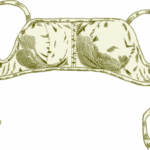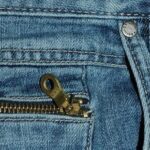How often can you find a pair of off-the-rack pants that fit your body perfectly? If the waist fits, then the inseam may be too long or short. Everyone seems to have this problem: children, teens, men, women, seniors and more.
What’s a fashion or family shopper to do?
Certainly, many stores offer tailoring services. You can pay up to $20, just for hemming a new pair of pants to your ideal length. For family apparel or even school uniforms, this can add up quickly!
Hemming a pair of pants is not that technical or difficult, so why not save the money, and do it yourself?
It’s sew simple to tailor-hem a pair of trousers!
First, plug in your steam iron. Look inside your trousers for a fabric care label. This will indicate the appropriate heat setting for your iron.
While your iron heats up, you can gather your sewing notions. You will need a needle, a ruler, a pair of scissors and several straight pins. Choose thread to match the background color of your garment, as closely as possible.
You can hem your pants with or without a sewing machine (see below).
Try on your new trousers.
Even if you tried on your new pants in the fitting room at the store, you will need to put them on again at home. Put on the shoes you plan to wear with this pair of pants.
If you can, ask someone else to stick a straight pin into one leg of your pants, right where you wish to fold them up into your new hem. Usually, this is the spot where the pants meet the top of your shoes, but you can adjust this to fit your current style.
Aim the pin horizontally, so it is positioned level to the floor.
Turn your garment inside out.
Pants are hemmed from the inside, so the stitching is virtually invisible. (Cuffed pants are often an exception, but this is a more complicated endeavor.)
Turn your trousers inside out before you begin working on them.
Measure exactly for perfect hemming.
You can do this on top of your ironing board. Roll each pant leg to the length you wish. Measure carefully with a ruler, so your hems will be even all the way around. Pin your pants about an inch from the edge, as you go.
Press your new hemline into place, easing as needed. (Flared and bell-bottomed pants may require a bit of easing to nudge hem allowances into place. Done neatly, this will not show from the outside of each pant leg.)
Press both pant legs flat against each other to check that they are exactly the same length.
Should you trim extra hemmage?
This is a matter of personal choice. If your new hem allowances are more than 2″ to 3″ deep, you may choose to trim off a bit. Of course, if you do, you will have to finish the new raw edges (see below).
If you are hemming a pair of pants for a growing child, you may choose to leave the hem allowances intact. This will give you the option of lengthening the trousers after the child experiences a growth spurt.
Finish off any rough edges.
If you have merely tucked up the old finished hem on your pants, then you can skip this step.
However, if you have trimmed off extra hem allowances, then you will need to take care of the rough edges for neatness and fray prevention. Simply tuck under a small portion (approximately 1/8″ to 1/4″), all the way around each of your pant legs. Use the ruler to check your work for consistency.
Press both hem allowances (both pant legs) neatly before proceeding.
Stitch your trouser hems.
You can hem your pants by hand or on a sewing machine. Some tailors employ a blind-stitch for this purpose. If your machine offers this stitching option, your owner’s manual will provide specific instructions for operating your machine’s controls and performing this stitch.
Narrow pant legs, such as one might find on stovepipe pants or skinny jeans, are easiest to sew by hand. These can be difficult to accomplish on a sewing machine, unless it has a very narrow base option. Because flared and bell-bottom hems often require a bit of easing and adjustment, these may also be easier to manage with hand-sewing.
Use a basic blanket stitch for hand-sewing your trouser hems. Thread your sewing needle, and knot the thread securely. Start sewing right at the inseam of one pant leg (the seam between the legs of the pants), and sew all the way around to the same spot. Repeat the process with the other leg.
Blue jeans and athletic wear may be topstitched, if you are a very capable and steady sewer. You can select a straight stitch (or a narrow zigzag for knits), to sew your hems.
Make sure you remove all pins and clip all excess threads before giving your pants a final pressing for wear.



